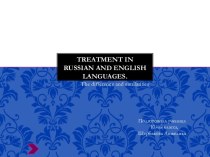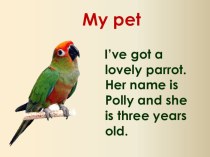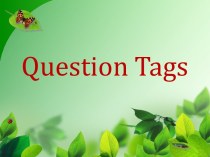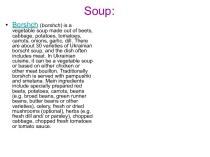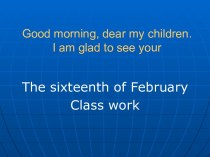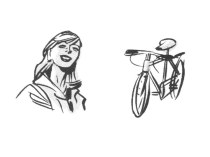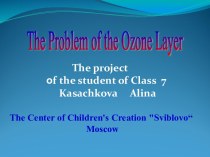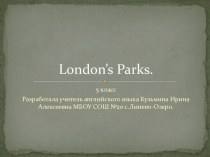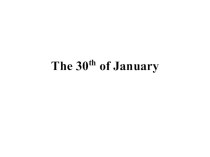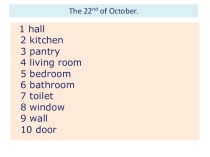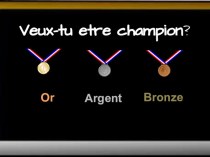- Главная
- Разное
- Бизнес и предпринимательство
- Образование
- Развлечения
- Государство
- Спорт
- Графика
- Культурология
- Еда и кулинария
- Лингвистика
- Религиоведение
- Черчение
- Физкультура
- ИЗО
- Психология
- Социология
- Английский язык
- Астрономия
- Алгебра
- Биология
- География
- Геометрия
- Детские презентации
- Информатика
- История
- Литература
- Маркетинг
- Математика
- Медицина
- Менеджмент
- Музыка
- МХК
- Немецкий язык
- ОБЖ
- Обществознание
- Окружающий мир
- Педагогика
- Русский язык
- Технология
- Физика
- Философия
- Химия
- Шаблоны, картинки для презентаций
- Экология
- Экономика
- Юриспруденция
Что такое findslide.org?
FindSlide.org - это сайт презентаций, докладов, шаблонов в формате PowerPoint.
Обратная связь
Email: Нажмите что бы посмотреть
Презентация на тему Spin the wheel
Содержание
- 2. Team 1Team 2Team 3Team 4Team 5Team 6SCORE50100200150250150200502501501002501505015020025025010050200100200250150THE ENDCLICK TO SPIN
- 3. 100Rewrite the following in the PASSIVE VOICE.
- 4. 50I’m sorry I can’t help you.I
- 5. 200Although he has a bad temper/ he
- 6. 150If she had any/more friends, she wouldn’t
- 7. 2501) Sam, who is my best friend,
- 8. 150He is being offered a new position.Rewrite
- 9. 2001) 2) and 4)Which options are possible?“He
- 10. 50PRESENT SIMPLE vs PRESENT CONTINUOUSam working
- 11. 250Rephrase the following.…if she knew where he
- 12. 150… to call me a taxi.Report the
- 13. 100has been livingComplete the sentence with the
- 14. 250better / more confidentChange the words in
- 15. 150Can/may I take the day off?Rephrase the
- 16. 50was having / rangI … (have)
- 17. 150Rephrase the following with “so that”.I’m moving
- 18. 200He is said to speak 8 languages.ALTERNATIVE
- 19. 250… did I know where I was.Rephrase
- 20. 250He is thought to have stolen the
- 21. 100Will Kate be back soon?QUESTIONS Ask me
- 22. 50have met / didn’t seeI …
- 23. 200If he hadn’t been late, he would
- 24. 100SUBJECT QUESTIONS - Ask the question for
- 25. 200I … (finish) this by the time
- 26. 250Rephrase the following.… being disturbed at work.I
- 27. Скачать презентацию
- 28. Похожие презентации


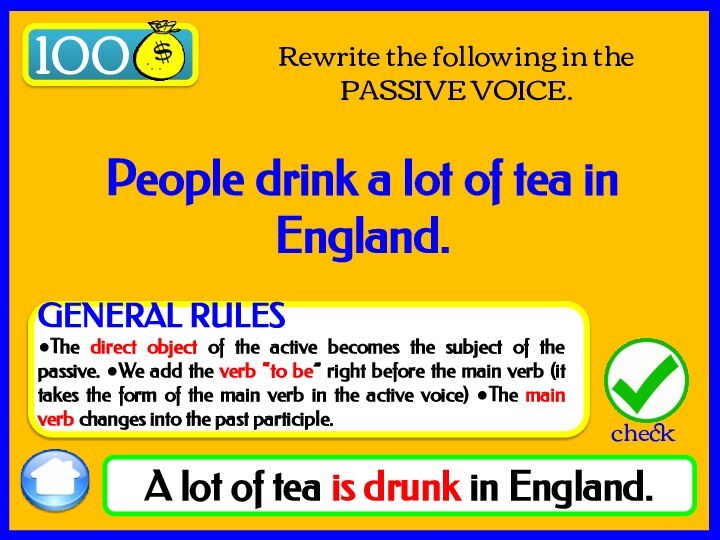
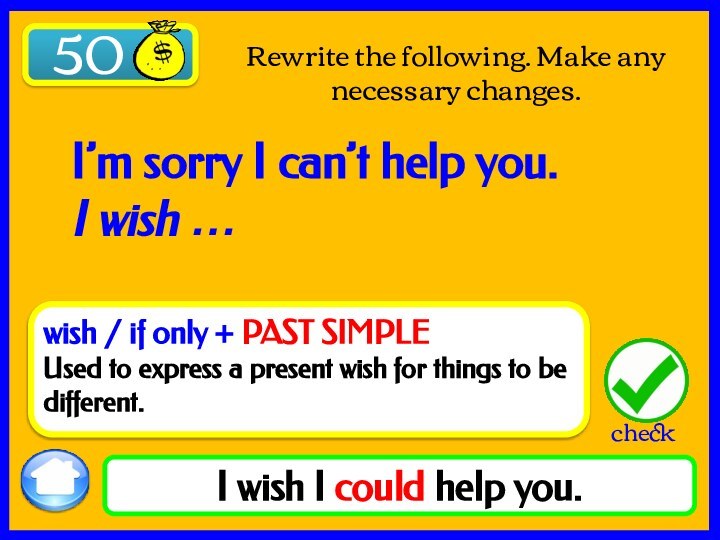
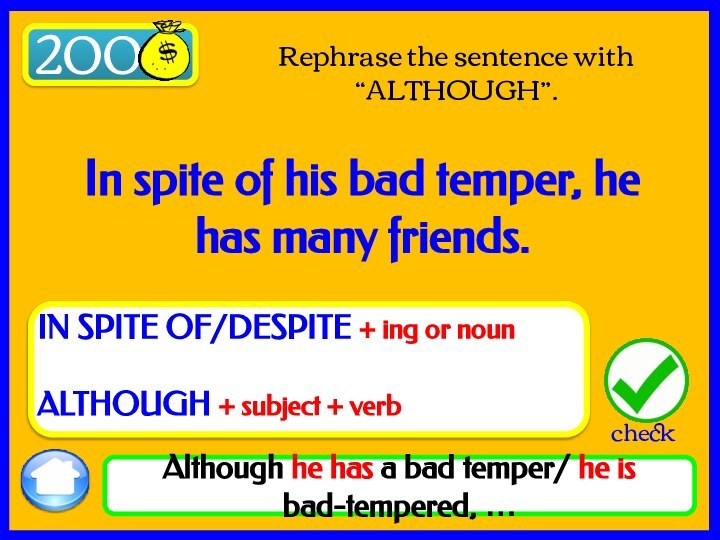
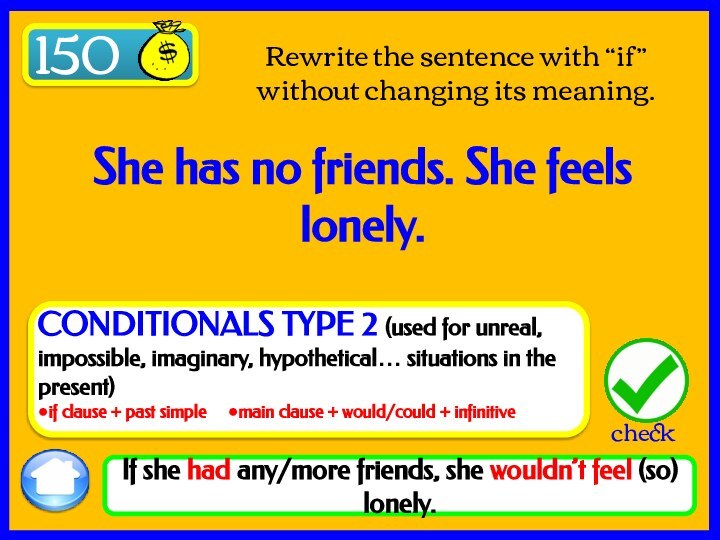
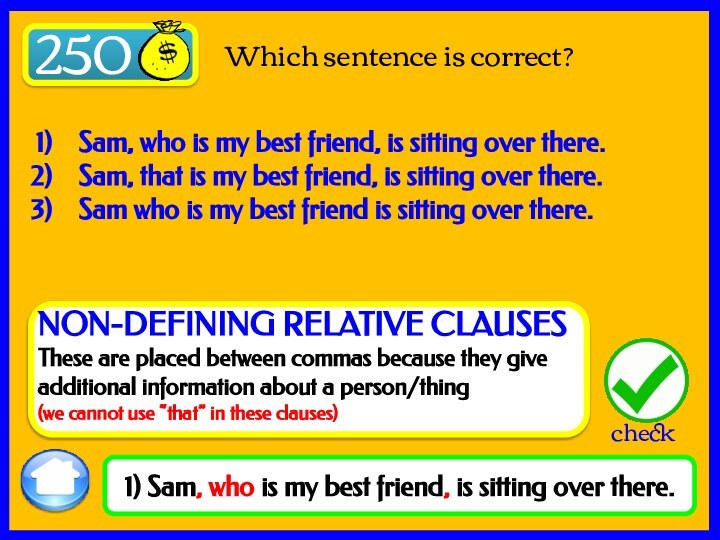

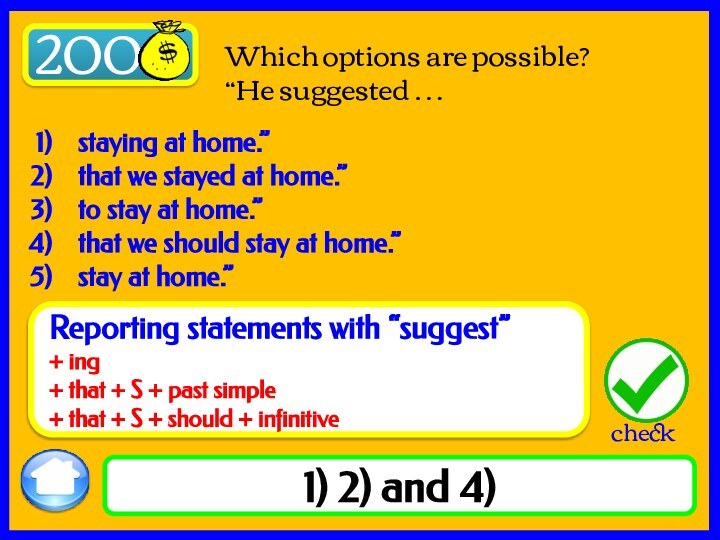
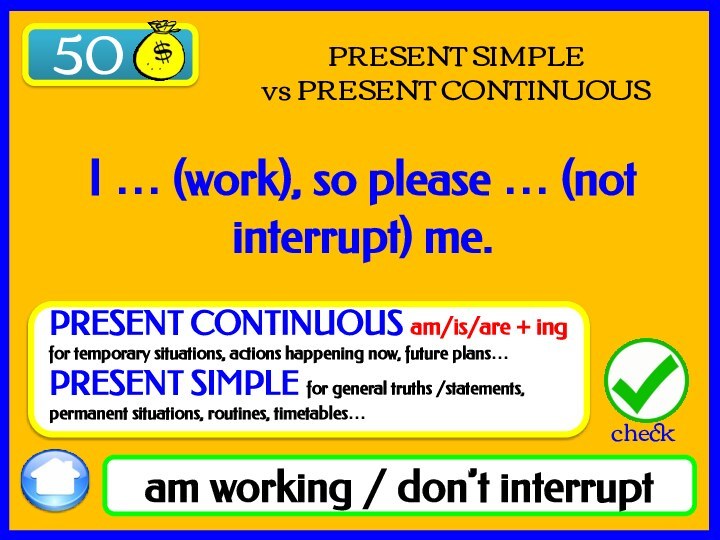
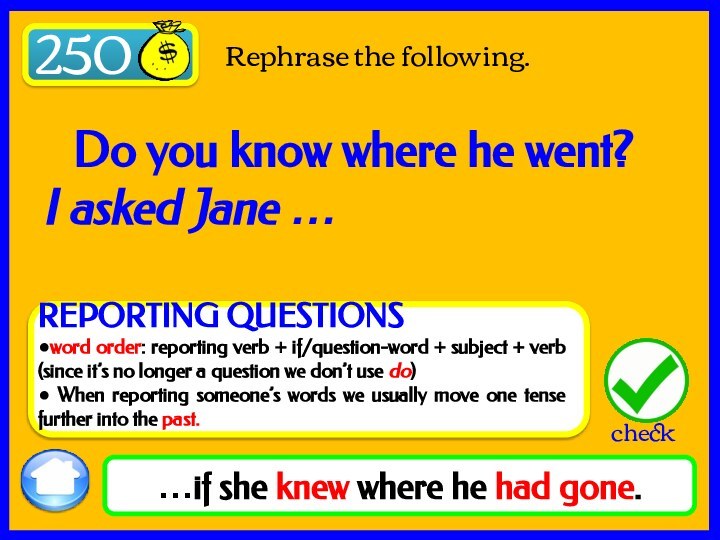
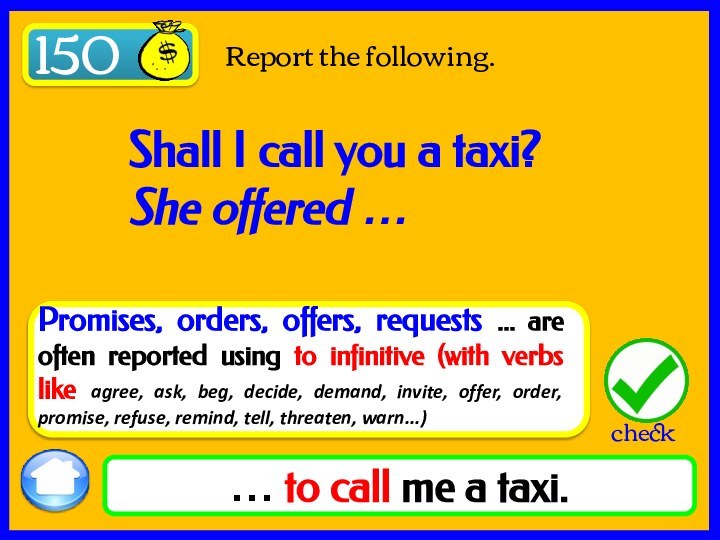
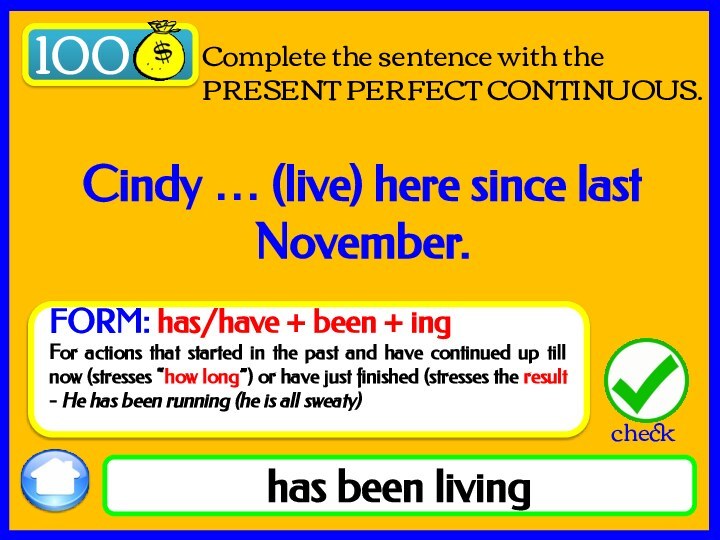
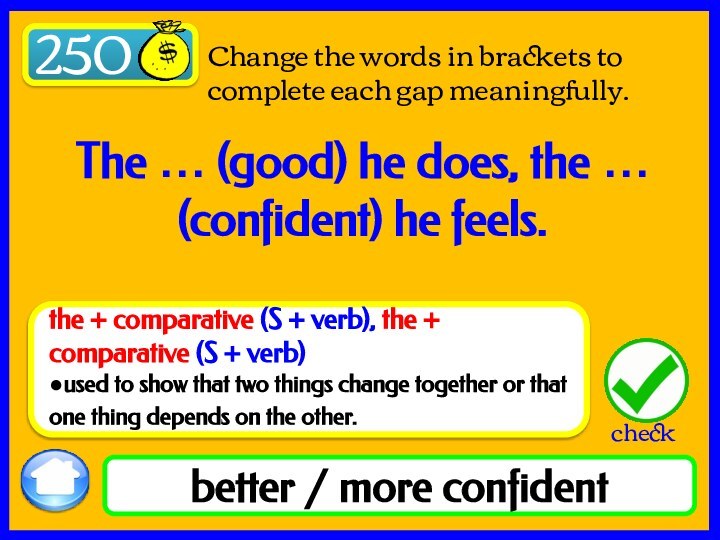
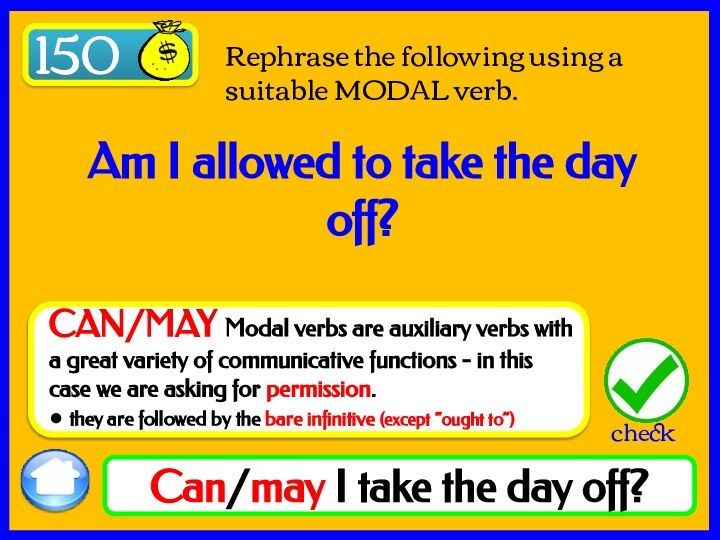
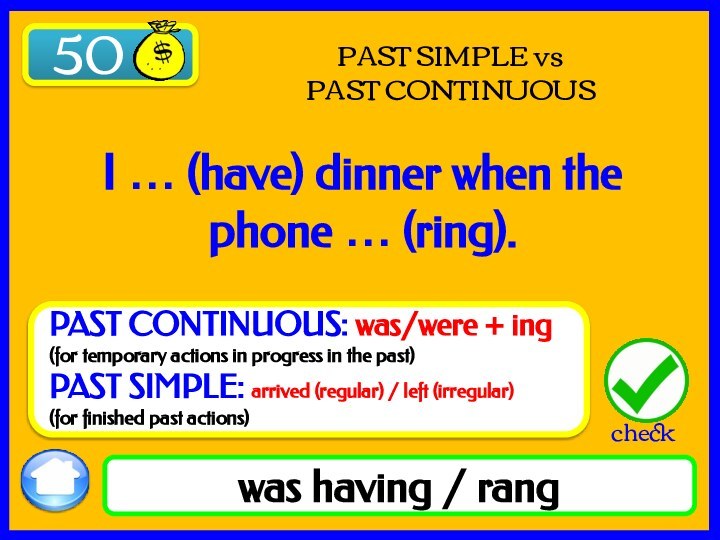
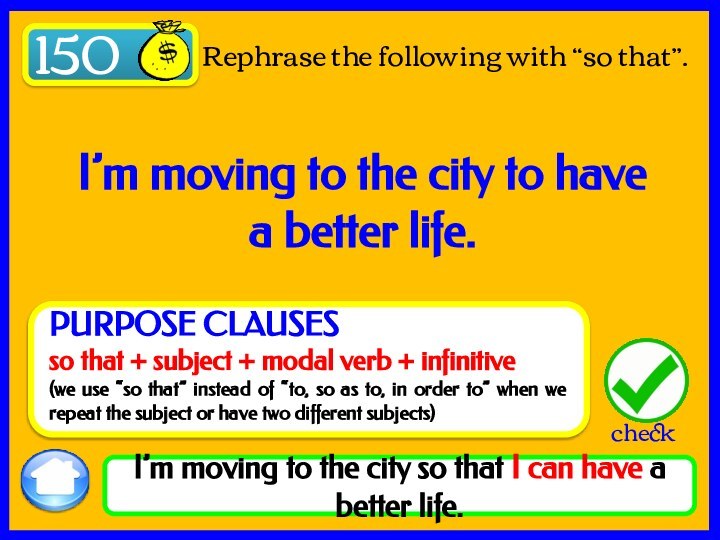
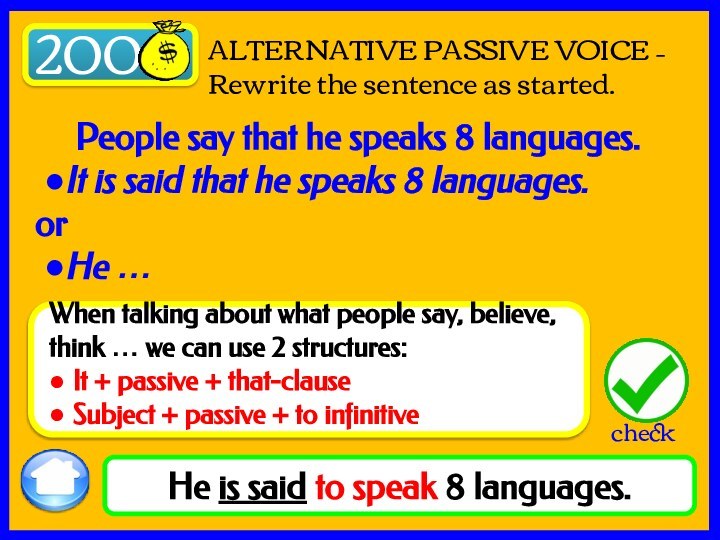
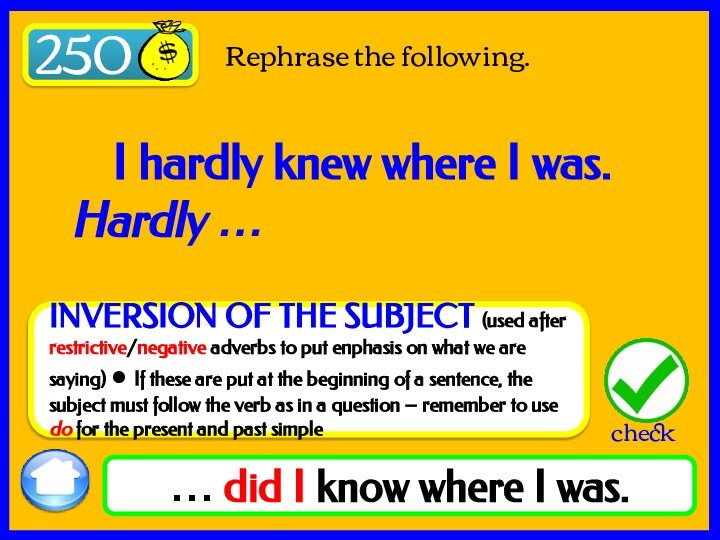
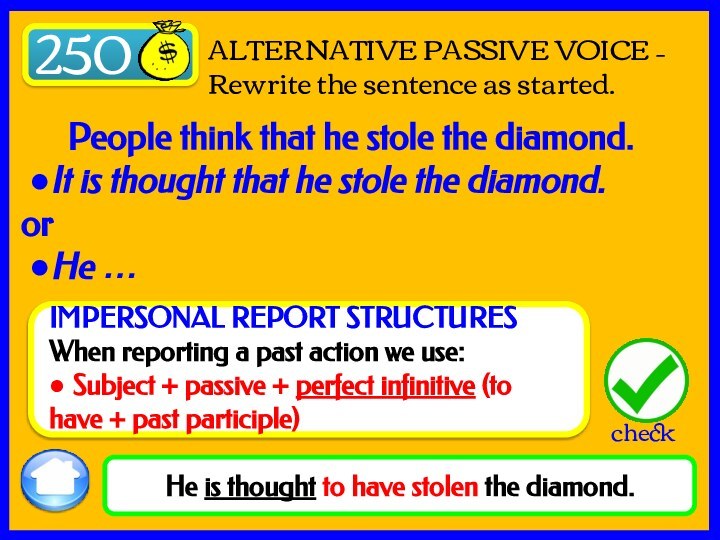
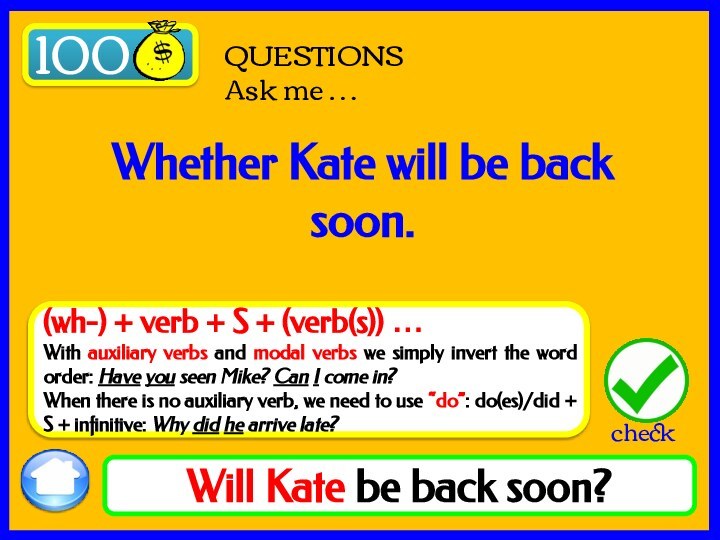
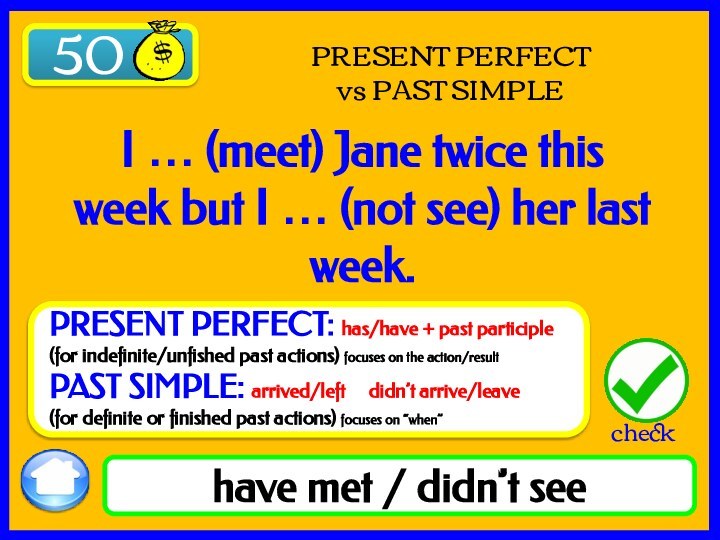
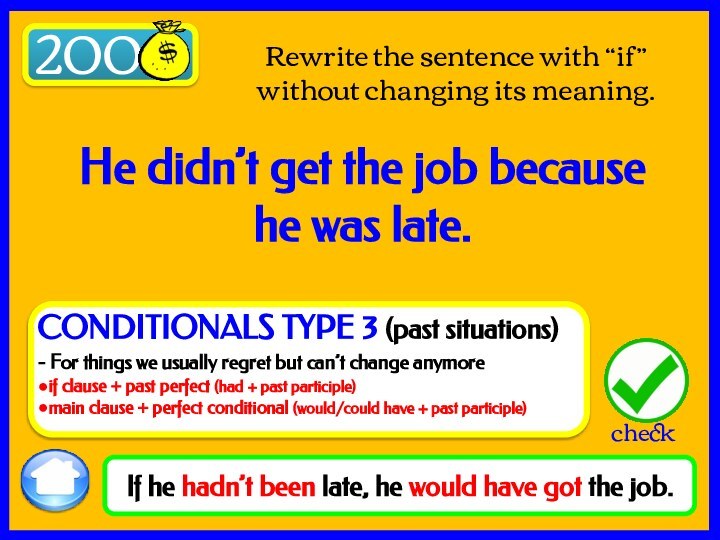
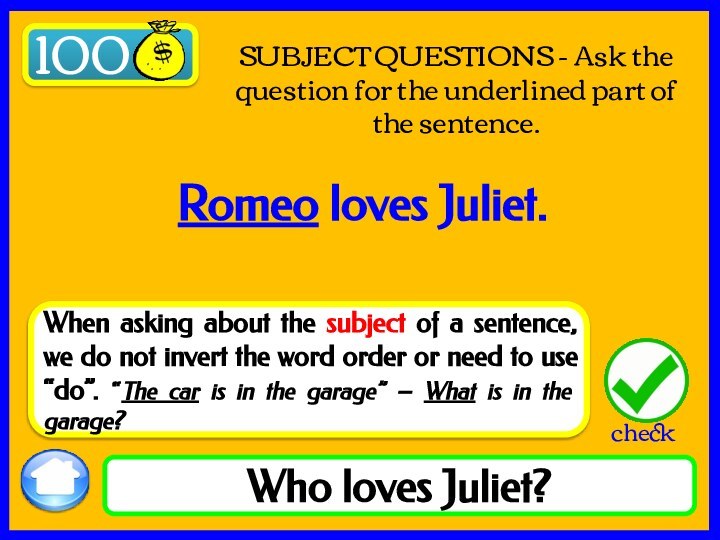
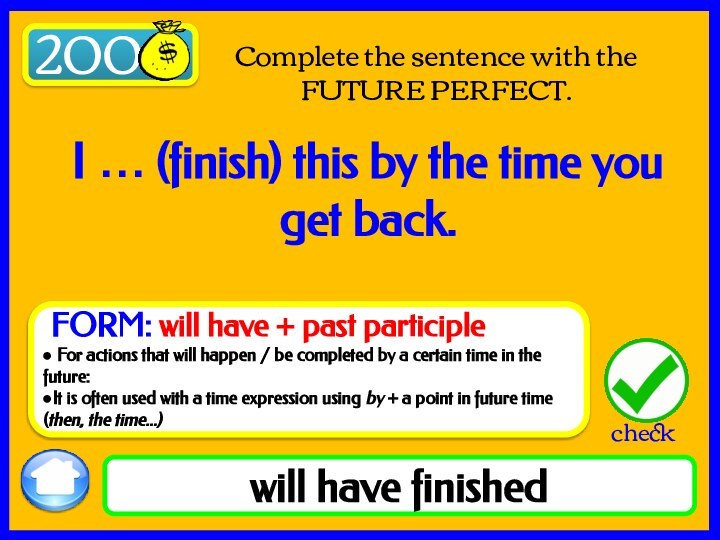
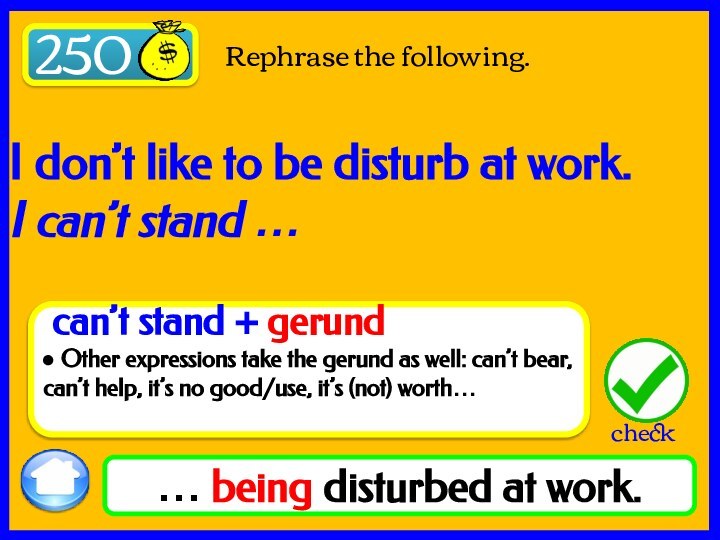
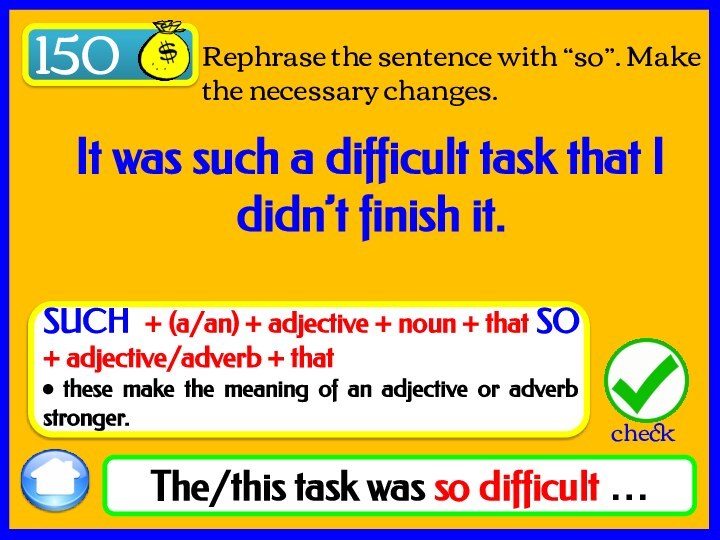
Слайд 2
Team 1
Team 2
Team 3
Team 4
Team 5
Team 6
SCORE
50
100
200
150
250
150
200
50
250
150
100
250
150
50
150
200
250
250
100
50
200
100
200
250
150
T
H
E
E
N
D
CLICK
TO SPIN
Слайд 3
100
Rewrite the following in the PASSIVE VOICE.
A
lot of tea is drunk in England.
People drink a
lot of tea in England.GENERAL RULES
●The direct object of the active becomes the subject of the passive. ●We add the verb “to be” right before the main verb (it takes the form of the main verb in the active voice) ●The main verb changes into the past participle.
Слайд 4
50
I’m sorry I can’t help you.
I wish
…
I wish I could help you.
Rewrite the following. Make
any necessary changes.wish / if only + PAST SIMPLE
Used to express a present wish for things to be different.
Слайд 5
200
Although he has a bad temper/ he is
bad-tempered, …
Rephrase the sentence with “ALTHOUGH”.
In spite of his
bad temper, he has many friends. IN SPITE OF/DESPITE + ing or noun
ALTHOUGH + subject + verb
Слайд 6
150
If she had any/more friends, she wouldn’t feel
(so) lonely.
Rewrite the sentence with “if” without changing
its meaning.She has no friends. She feels lonely.
CONDITIONALS TYPE 2 (used for unreal, impossible, imaginary, hypothetical… situations in the present)
●if clause + past simple ●main clause + would/could + infinitive
Слайд 7
250
1) Sam, who is my best friend, is
sitting over there.
Which sentence is correct?
Sam, who is
my best friend, is sitting over there.Sam, that is my best friend, is sitting over there.
Sam who is my best friend is sitting over there.
NON-DEFINING RELATIVE CLAUSES
These are placed between commas because they give additional information about a person/thing
(we cannot use “that” in these clauses)
Слайд 8
150
He is being offered a new position.
Rewrite the
following as started.
They are offering him a new position.
He …
IDIOMATIC PASSIVE VOICE
● In this case the indirect object of the active becomes the subject of the passive. However, you can start with the direct object – A new position is being offered to him.
Слайд 9
200
1) 2) and 4)
Which options are possible?
“He suggested
…
Reporting statements with “suggest”
+ ing
+ that + S
+ past simple+ that + S + should + infinitive
staying at home.”
that we stayed at home.”
to stay at home.”
that we should stay at home.”
stay at home.”
Слайд 10
50
PRESENT SIMPLE
vs PRESENT CONTINUOUS
am working /
don’t interrupt
I … (work), so please … (not interrupt)
me.PRESENT CONTINUOUS am/is/are + ing for temporary situations, actions happening now, future plans… PRESENT SIMPLE for general truths /statements, permanent situations, routines, timetables…
Слайд 11
250
Rephrase the following.
…if she knew where he had
gone.
Do you know where he went?
I asked Jane
…REPORTING QUESTIONS
●word order: reporting verb + if/question-word + subject + verb (since it’s no longer a question we don’t use do)
● When reporting someone’s words we usually move one tense further into the past.
Слайд 12
150
… to call me a taxi.
Report the following.
Shall
I call you a taxi?
She offered …
Promises, orders,
offers, requests ... are often reported using to infinitive (with verbs like agree, ask, beg, decide, demand, invite, offer, order, promise, refuse, remind, tell, threaten, warn...)
Слайд 13
100
has been living
Complete the sentence with the PRESENT
PERFECT CONTINUOUS.
Cindy … (live) here since last November.
FORM: has/have
+ been + ingFor actions that started in the past and have continued up till now (stresses “how long”) or have just finished (stresses the result - He has been running (he is all sweaty)
Слайд 14
250
better / more confident
Change the words in brackets
to complete each gap meaningfully.
The … (good) he does,
the … (confident) he feels.the + comparative (S + verb), the + comparative (S + verb)
●used to show that two things change together or that one thing depends on the other.
Слайд 15
150
Can/may I take the day off?
Rephrase the following
using a suitable MODAL verb.
Am I allowed to take
the day off?CAN/MAY Modal verbs are auxiliary verbs with a great variety of communicative functions - in this case we are asking for permission.
● they are followed by the bare infinitive (except “ought to”)
Слайд 16
50
was having / rang
I … (have) dinner
when the phone … (ring).
PAST CONTINUOUS: was/were + ing
(for
temporary actions in progress in the past)PAST SIMPLE: arrived (regular) / left (irregular)
(for finished past actions)
PAST SIMPLE vs
PAST CONTINUOUS
Слайд 17
150
Rephrase the following with “so that”.
I’m moving to
the city so that I can have a better
life.I’m moving to the city to have a better life.
PURPOSE CLAUSES
so that + subject + modal verb + infinitive
(we use “so that” instead of “to, so as to, in order to” when we repeat the subject or have two different subjects)
Слайд 18
200
He is said to speak 8 languages.
ALTERNATIVE PASSIVE
VOICE – Rewrite the sentence as started.
People say that
he speaks 8 languages.●It is said that he speaks 8 languages.
or
●He …
When talking about what people say, believe, think … we can use 2 structures:
● It + passive + that-clause
● Subject + passive + to infinitive
Слайд 19
250
… did I know where I was.
Rephrase the
following.
I hardly knew where I was.
Hardly …
INVERSION OF THE
SUBJECT (used after restrictive/negative adverbs to put enphasis on what we are saying) ● If these are put at the beginning of a sentence, the subject must follow the verb as in a question – remember to use do for the present and past simple
Слайд 20
250
He is thought to have stolen the diamond.
ALTERNATIVE
PASSIVE VOICE – Rewrite the sentence as started.
People think
that he stole the diamond.●It is thought that he stole the diamond.
or
●He …
IMPERSONAL REPORT STRUCTURES
When reporting a past action we use:
● Subject + passive + perfect infinitive (to have + past participle)
Слайд 21
100
Will Kate be back soon?
QUESTIONS
Ask me …
Whether
Kate will be back soon.
(wh-) + verb +
S + (verb(s)) …With auxiliary verbs and modal verbs we simply invert the word order: Have you seen Mike? Can I come in?
When there is no auxiliary verb, we need to use “do”: do(es)/did + S + infinitive: Why did he arrive late?
Слайд 22
50
have met / didn’t see
I … (meet)
Jane twice this week but I … (not see)
her last week.PRESENT PERFECT: has/have + past participle
(for indefinite/unfished past actions) focuses on the action/result
PAST SIMPLE: arrived/left didn’t arrive/leave
(for definite or finished past actions) focuses on “when”
PRESENT PERFECT
vs PAST SIMPLE
Слайд 23
200
If he hadn’t been late, he would have
got the job.
Rewrite the sentence with “if” without changing
its meaning.He didn’t get the job because he was late.
CONDITIONALS TYPE 3 (past situations)
- For things we usually regret but can’t change anymore
●if clause + past perfect (had + past participle)
●main clause + perfect conditional (would/could have + past participle)
Слайд 24
100
SUBJECT QUESTIONS - Ask the question for the
underlined part of the sentence.
Who loves Juliet?
Romeo loves Juliet.
When
asking about the subject of a sentence, we do not invert the word order or need to use “do”. “The car is in the garage” – What is in the garage?
Слайд 25
200
I … (finish) this by the time you
get back.
will have finished
Complete the sentence with the FUTURE
PERFECT. FORM: will have + past participle
For actions that will happen / be completed by a certain time in the future:
It is often used with a time expression using by + a point in future time (then, the time...)
Слайд 26
250
Rephrase the following.
… being disturbed at work.
I don’t
like to be disturb at work.
I can’t stand
… can’t stand + gerund
Other expressions take the gerund as well: can’t bear, can’t help, it’s no good/use, it’s (not) worth…



